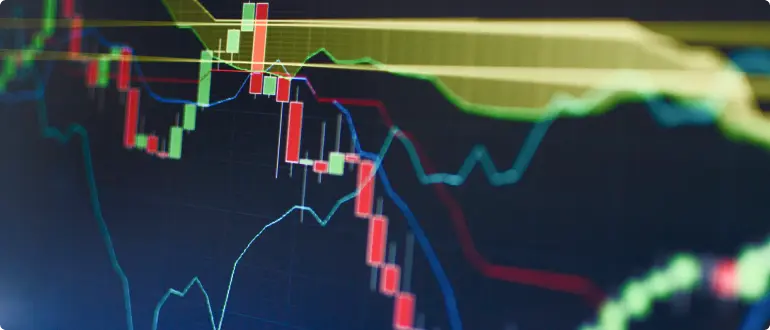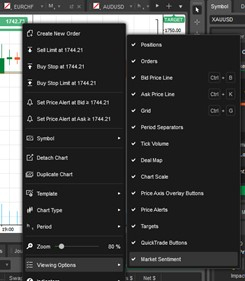What is forex market sentiment: analysis, indicators & strategy with FxPro

Table of Contents
- Forex Sentiment Analysis
- How to trade with market sentiment
- Indicators of market sentiment
- Using the Commitments of Traders Report
- VIX (Volatility Index) Sentiment Indicator
- Other indicators of market sentiment
- FxPro's Forex Sentiment Analysis tools
- Market Sentiment in conclusion
Simply put, market sentiment refers to the attitude or mood of investors in regards to a particular asset group or specific instrument. It is also often called 'investor sentiment.'
While Technical and fundamental analysis is the main methods used to assist in making trading decisions, knowing the fx sentiment of other traders can help you better understand price movements and manage your positions better.
In this article, we will explain how to determine and understand the market sentiment and how you can apply it to your trading strategy.
Forex Sentiment Analysis
Forex sentiment analysis is simply determining the number of traders who are long or short on a particular currency pair. For example, if 80% of traders are long on EURUSD, the pair is said to have bullish fx sentiment.
Bullish and bearish refers to whether price action is going up or down. Essentially the sentiment displays whether traders are optimistic or pessimistic towards a particular instrument or market, providing additional forex analysis insights.
Sentiment analysis applies not only to the forex market but also to stocks, commodities, indices etc.
How to trade with market sentiment
It is generally believed that the average trader, fuelled by greed and fear, overreacts to fundamental news and places too much importance on certain information that is not relevant in the long term.
Therefore, market sentiment should be used to trade in the opposite direction of the prevailing opinion. This is known as contrarian trading, which is characterised as going against the majority.
This means that traders should use the sentiment to identify possible reversals indicated by overbought or oversold conditions rather than following the crowd.
So, traders should look for extreme levels indicating overpriced or undervalued conditions where there may be an opportunity to take a position.
In simple terms, contrarian investors try to enter the market when there is a negative sentiment by most speculative traders. For example, it is believed that when sentiment is overly pessimistic, the price has already been pushed the price down to lower than the assets worth, giving an opening for the contrarian investor to buy the instrument at a low price and wait for the rebound.
On the flip side of that coin, if the market is overly optimistic, the buyers have already pushed the price to its peaks and will soon start to close positions to lock in profit, reversing towards a bearish sentiment, and prices may start to fall. These signals are much more reliable in long trending markets; therefore, it is not advisable to use market sentiment for short term trading or instruments that tend to range rather than moving in clear trends.
Although many traders find this strategy to be profitable, contrarian trading can be very risky and may take a long time to go your way.
Indicators of market sentiment
There are several technical indicators based on market sentiment. These will display the number of trades currently open in either direction, as a % or a simple number.
A sentiment indicator can help to detect when the market may be oversold or overbought.
However, they don't give direct signals for buying and selling; rather, they indicate possible reversals that should be confirmed by the price movement or strengthened by another technical indicator or fundamental analysis.
For example, if a forex pair has 95% of traders long and 5% short, it is an indication that the instrument may be running out of buyers to support the price increase, and a reversal may be on the horizon. Forex pairs, however, often stay at extreme levels for a prolonged period and therefore, the reversal may take time to occur.
Using the Commitments of Traders Report
This weekly report is released by the Commodity Futures Trading Commission (CFTC) every Friday at 15:30 Eastern Time. Since 1962, this report states investors' holdings in various futures markets; agricultural, oil and energies, financial instruments, metals and other commodities.
Reflecting the direction of positions from the previous Tuesday, and traders are split into three categories:
- Commerical
- Non-Commercial
- Nonreportable
Traders use this report to enter buy or sell positions based on the opposing majority trend. This is based on the theory that most speculative (nonreportable) traders are erroneous in their predictions, and therefore, it is ideal for taking an opposing position.
Commercial traders, on the other hand, usually have a better idea of how the market actually moves, so if, for example, the vast majority of speculative (nonreportable) traders are long, and a small group of commercial traders are short, it may be better to take a short position.
VIX (Volatility Index) Sentiment Indicator
The volatility index (VIX), or fear index as it is often known, is created and tracked by the CBOE (Chicago Board of Options Exchange), based on the volatility of the options of the broad S&P500 Index. This indicator helps to gauge whether institutions are hedging their positions.
When volatility is low, the VIX will have a low reading, and when volatility is high, so too is the VIX reading. A phrase you will commonly hear when talking about the VIX is that when the VIX is high, it's time to buy; if the Vix is low, it's time to go...
Essentially what this means is that when volatility is high, there is also a high level of fear, and it might be a good time to buy S&P stocks. This, however, is extremely subjective based on multiple other factors.
The VIX demonstrates the negative correlation between stock returns and volatility. So when stock returns are low, volatility increases, and vice versa.
Vix levels go from 10 to 85, although it tends to range typically between 18-35. Over the years, various support and residence levels have appeared within the VIX. Traders will often add moving averages in order to better understand its levels.
The CBOE offers a number of other volatility indexes, such as the short-term volatility index and the Cboe Russell 2000 Volatility Index.
Other indicators of market sentiment
The High Low Index: This index takes the number of stocks making 52-week highs and compares them to the stocks reaching 52-week lows.
Moving Averages: MA’s can be used to identify cross patterns that indicate a reversal in sentiment.
A Golden Cross appears when the 50 day SMA crosses above the 200 day SMA=Reversal towards bullish sentiment.
A death cross appears when the lines cross in the opposite direction=reversal towards bearish sentiment.
FxPro's Forex Sentiment Analysis tools
At FxPro, we provide a useful Traders dashboard tool that displays the current fx sentiment of FxPro Traders for the top traded forex pairs, providing a snapshot for your forex sentiment analysis. This is also accessible in the FxPro Direct portal.

The FxPro cTrader platform displays market sentiment directly on the chart, and this feature can be enabled/disabled through the 'viewing options' when you right-click on a chart.


Please note that this data is from all Spotware cTrader users, not only clients of FxPro.
It is important to identify the source of the data provided for forex sentiment analysis. For example, some brokers may offer market sentiment tools that collect data only from their customers, which could be different to other brokers depending on the size and type of clients.
Market Sentiment in conclusion
Whilst there are a number of different methods and choices of indicator available, it is important to research and fully understand how they work prior to taking any action based on them. Practice developing your trading skills on an FxPro demo account.




